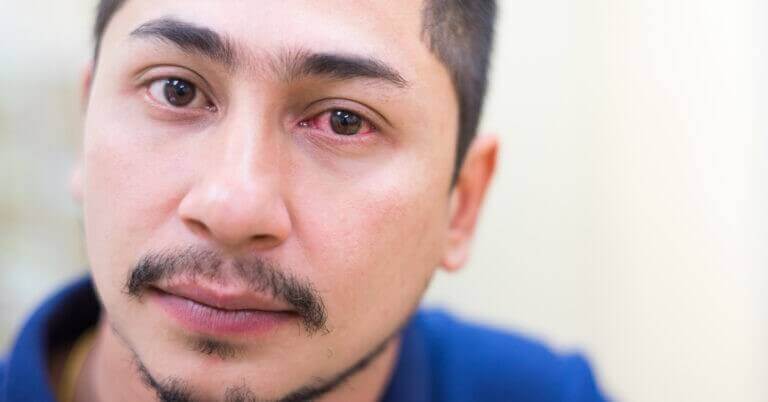Do you have a one-sided headache, left-sided headache, right-sided headache, or one-sided head pain with some variation of one-sided symptoms such as runny nose, nasal congestion or stuffiness, red eye, tearing eye, droopiness of the eyelid, puffiness or swelling around the eye, facial sweating or flushing, or clogged ear feeling?
These symptoms are called autonomic symptoms, and they are a central part of several distinct headache syndromes. The headaches that occur with this combination of features are distinct types of headaches, all requiring different treatments. Therefore, it is important in differentiating them to ensure proper treatment and less misery!
TRIGEMINAL AUTONOMIC CEPHALALGIAS (TACs)
There is a class of headaches called the trigeminal autonomic cephalalgias (TACs), and all are terribly painful. There are 4 types of headaches within the TAC family, and include cluster headache, hemicrania continua, paroxysmal hemicrania, and SUNCT / SUNA (Short-lasting unilateral neuralgiform headache attacks with conjunctival injection and tearing / Short-lasting unilateral neuralgiform headache attacks with cranial autonomic symptoms). All of the TAC syndromes warrant preferably a brain MRI and MRA to exclude other causes such as pituitary lesions, aneurysms, or other abnormalities.
The TACs all share 2 common and core features. 1st, they are characterized by a severe headache that is strictly one-sided and focused around the eye, behind the eye, below the eye, in the temple or forehead areas. 2nd, they must include at least 1 autonomic symptom on the same side of the headache [lacrimation (runniness/tearing of the eye), conjunctival injection (redness of the eye), facial sweating or flushing (skin turning blushed), nasal congestion, rhinorrhea (runniness of nose), sense of ear fullness, eyelid edema (swelling), or partial Horner’s syndrome (miosis (pupil becomes small)) and/or ptosis (droopiness of the eye)].
So how do you differentiate these headache types when they all have similar features? Differentiation between them is based purely on their headache attack duration and pattern. So, it is actually quite easy to differentiate them as contrasted below.
CLUSTER HEADACHE
Cluster headache is the most common TAC syndrome and is discussed and detailed further here. It is characterized by attacks of severe unilateral (one-sided) orbital (around the eye), supraorbital (above the eye), and/or temporal pain lasting 15 to 180 minutes if untreated. There is either agitation/restlessness with the headache attack and/or at least 1 autonomic sign or symptom on the side of the headache as described above. Headache attacks typically occur from 1 every other day to 8 per day for more than half the time during a cluster cycle. Chronic cluster headache is defined by attacks that occur for more than 1 year without remission, or with remission periods lasting less than 1 month.
Cluster headache attacks occur in “clusters”, or cycles, of frequent headache attacks. These cycles of cluster attacks may last for weeks or months before they go away completely. Within a cluster cycle, patients may get multiple attacks during the day or overnight. They often classically wake the patient up in the middle of sleep, usually around the same time every night or morning. The patient often gets up and paces around the house in agitated misery. They certainly can occur during the day as well. Remission periods can last months to years. Cluster cycles often occur at a predictable time of year, such as season changes (Fall and Spring are most common). Men tend to be affected 3 times more than women, but it is seen in both men and women. It is a severely painful headache, and has been termed “suicide headache” because of the pain severity.
Treatment of cluster headache is detailed further here.
HEMICRANIA CONTINUA
Hemicrania continua a continuous daily one-sided headache (side-locked, does not alternate sides) of at least 3 months duration with moderate to severe exacerbations. There should be either agitation or restlessness and/or at least 1 autonomic sign or symptom on the side of the headache as described above. Although not included in the criteria, sometimes patients describe a sensation such as something irritating in the eye on the side of the headache, such as sand, grit, or a hair, but nothing is found. Hemicrania continua is discussed and detailed further here.
To make the full diagnosis of hemicrania continua, the patient must respond completely to a therapeutic trial of indomethacin (a specific anti-inflammatory (NSAID) medication), used in a very specific way (“Indomethacin trial”). For this reason, this headache is 1 of 2 types of “Indomethacin-sensitive” headaches because Indomethacin is typically the only thing that works (paroxysmal hemicrania is the other Indomethacin-sensitive headache). The diagnosis of hemicrania continua is confirmed by the headache completely stopping after reaching a specific dose of Indomethacin.
Besides indomethacin, other treatments of hemicrania continua are detailed further here.
PAROXYSMAL HEMICRANIA
Paroxysmal hemicrania is characterized by attacks of severe unilateral (one-sided) orbital (around the eye), supraorbital (above the eye), and/or temporal pain lasting 2 to 30 minutes. There must be at least 1 autonomic sign or symptom on the side of the headache as described above. The attacks have a frequency of more than 5 per day for more than 50% of the time when the disorder is active. Chronic paroxysmal hemicrania continua is defined by attacks occurring for more than 1 year without remission, or with remission periods lasting less than 1 month. Paroxysmal hemicrania is discussed and detailed further here.
To make the full diagnosis of paroxysmal hemicrania, the patient must respond completely to a therapeutic trial of indomethacin (a specific anti-inflammatory (NSAID) medication), used in a very specific way (“Indomethacin trial”). For this reason, this headache is 1 of 2 types of “Indomethacin-sensitive” headaches because Indomethacin is typically the only thing that works (hemicrania continua is the other “Indomethacin-sensitive” headache). The diagnosis of paroxysmal hemicrania is confirmed by the headache completely stopping after reaching a specific dose of Indomethacin.
Besides indomethacin, other treatments of paroxysmal hemicrania are detailed further here.
SUNCT / SUNA
SUNCT/SUNA are two variations of a rare type of headache called short-lasting unilateral neuralgiform headache attacks, and they are discussed and detailed further here. Short-lasting unilateral neuralgiform headache attacks (which include SUNCT and SUNA) are characterized by moderate to severe unilateral (one-sided) orbital (around the eye), supraorbital (above the eye), and/or temporal pain. The duration of the pain lasts for 1–600 seconds (1 second to 10 minutes, although most often about 5 seconds to 4 minutes), and may occur as single stabs, series of stabs, or in a sawtooth pattern. There must be at least 1 autonomic sign or symptom on the side of the headache as described above. Attacks must have a frequency of at least one per day for more than half of the time when the disorder is active. However, the attacks generally occur in a very high daily frequency when active, sometimes even up to 200 attacks per day or 5-6 attacks per hour.
SUNCT and SUNA both share the above criteria. The difference between the two is that SUNCT requires both conjunctival injection (redness of the eye) and lacrimation (runniness/tearing of the eye), whereas SUNA requires only 1 or neither of these 2 features.
Treatment of SUNCT / SUNA is detailed further here.
MIGRAINE
Migraine is not a TAC syndrome, but it can sometimes have overlapping characteristics with the TACs in terms of its one-sided nature and associated autonomic features in some patients. For this reason, I have included it in this discussion. Migraine is discussed and detailed further here. The autonomic symptoms seen in migraine are not required by criteria for diagnosis, in contrast to the TAC syndromes which do require these symptoms for diagnosis. In some patients with migraine, their headache attacks can have some of the autonomic features described above. For many patients, migraine also activates the sinus pathways, so sinus symptoms of sinus/facial pressure, congestion and drainage are common. This is often misdiagnosed as “sinus headache”. However, if there is any throbbiness, pulsating, or pounding, it is almost guaranteed to actually be of a migraine origin rather than of a sinus origin.
Migraine headache attacks last 4 to 72 hours if untreated or unsuccessfully treated. There must be 2 of the following 4 features present: a unilateral (one-sided) headache, pounding/throbbing/pulsating quality, moderate-to-severe pain intensity, and worsening by routine physical activity. There must also be 1 of the following 2 features present: nausea and/or vomiting, or both photophobia (sensitivity to light) and phonophobia (sensitivity to sound).
Treatment of migraine headache is detailed further here.
IF YOU HAVE HEADACHE, MIGRAINE, OR FACIAL PAIN AND ARE LOOKING FOR ANSWERS ON ANYTHING RELATED TO IT, A HEADACHE SPECIALIST IS HERE TO HELP, FOR FREE!
FIRST, LET’S DECIDE WHERE TO START:
IF YOU HAVE AN EXISTING HEADACHE, MIGRAINE, OR FACIAL PAIN DIAGNOSIS AND ARE LOOKING FOR THE LATEST INFORMATION, HOT TOPICS, AND TREATMENT TIPS, VISIT OUR FREE BLOG OF HOT TOPICS AND HEADACHE TIPS HERE. THIS IS WHERE I WRITE AND CONDENSE A BROAD VARIETY OF COMMON AND COMPLEX MIGRAINE AND HEADACHE RELATED TOPICS INTO THE IMPORTANT FACTS AND HIGHLIGHTS YOU NEED TO KNOW, ALONG WITH PROVIDING FIRST HAND CLINICAL EXPERIENCE FROM THE PERSPECTIVE OF A HEADACHE SPECIALIST.
IF YOU DON’T HAVE AN EXISTING HEADACHE, MIGRAINE, OR FACIAL PAIN DIAGNOSIS AND ARE LOOKING FOR POSSIBLE TYPES OF HEADACHES OR FACIAL PAINS BASED ON YOUR SYMPTOMS, USE THE FREE HEADACHE AND FACIAL PAIN SYMPTOM CHECKER TOOL DEVELOPED BY A HEADACHE SPECIALIST NEUROLOGIST HERE!
IF YOU HAVE AN EXISTING HEADACHE, MIGRAINE, OR FACIAL PAIN DIAGNOSIS AND ARE LOOKING FOR FURTHER EDUCATION AND SELF-RESEARCH ON YOUR DIAGNOSIS, VISIT OUR FREE EDUCATION CENTER HERE.


